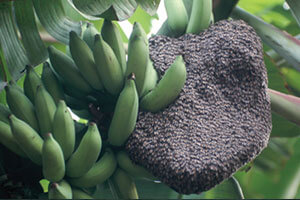
In North America, we only have one species of honey bee, Apis mellifera. Asia has approximately nine honey bee species. One of these is the little honey bee or dwarf honey bee, which are two common names for Apis florea, a bee smaller than our honey bee, Apis mellifera. This bee, Apis florea, is an open nester, meaning it builds a single comb from typically a branch or other structure (see Figure 1), not multiple combs within a cavity. (After mentioning the scientific name, it is customary to abbreviate its first name, here from Apis florea to A. florea.)
I had the opportunity to study A. florea while in Thailand and India. I found A. florea to be a fascinating and versatile bee. Besides living in rural areas, A. florea survives in urban areas too (Figures 2 and 3). Not only did the bee forage on cut flowers in cities in Thailand, but I saw them go after sweet candies sold in New Delhi, India. Dozens of tiny worker bees came for a taste. Street vendors had to cover their sweet treats with fine white netting, letting customers still see their goods, but stopping the relentless the little bees scrambling over the netted barrier hunting a hole to get inside, so close to the sweet yet denied.
With the bees at the sweet candies, their nest is probably not too far away, perhaps less than a couple of city blocks. Getting a direction from the candy-foraging bees at the vending carts back to their nest is difficult. They hardly buzz in flight, and they are so small. From flowers in a rural area, the little bees I saw flew low, and they blended into the background, quickly disappearing in a blur. That is part of their defense–stealth.
At the single exposed comb, the top of it bulges into a wide flat-top crest. Here is where highly successful foragers perform their waggle dances. However on a horizontal surface, the waggle run of the dance points directly to the food source. A. florea does not dance on the vertical comb face like A. mellifera, and thus does not need to represent the angle between the sun and food source as the angle between the vertical and food source (see Figure 4).
When finding A. florea colonies in their active season, they may be in various reproductive states. The bee curtain covering the comb is quite thick as shown in Figure 1 unless the colony recently swarmed. Then the comb edges may become visible (see Figure 5). Along with the population reduction from swarming, queen cells may become visible at the bottom of the comb, revealing familiar biology with our bees, A. mellifera. In Figure 6, the bees have removed the wax from the tip and …
PHOTO CAPTION
Figure 1. An Apis florea colony in a banana tree in India. This is not a swarm, but rather a colony, which appears flat because a curtain of bees covers the comb. The bees build only one comb in the open. The combs vary in size with a maximum about the size of a dinner plate.


